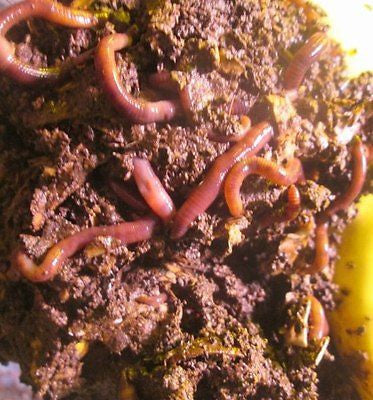Utilizing Red Wigglers for Efficient Organic Waste Disposal
These worms not just enhance waste decomposition yet additionally produce useful worm spreadings, which can substantially improve soil wellness. Recognizing the subtleties of setting up an effective worm container and preserving an optimal environment is critical for maximizing their benefits.
Advantages of Making Use Of Red Wigglers
Among the most engaging benefits of using red wigglers for natural garbage disposal is their impressive effectiveness in composting. These worms, clinically known as Eisenia fetida, are especially adjusted for breaking down organic products, enabling them to refine waste as much as two times their body weight daily. This quick disintegration not only speeds up the composting process however also produces nutrient-rich worm spreadings that considerably enhance dirt quality.
Additionally, red wigglers add to a decrease in landfill waste. By drawing away natural materials from land fills, they aid lessen methane emissions-- a powerful greenhouse gas. This ecological benefit is crucial in the battle against environment change.
Additionally, red wigglers are low-maintenance and can thrive in different settings, making them easily accessible for both beginner and seasoned composters. Their ability to replicate quickly makes sure a constant population, promoting ongoing waste handling.
Establishing Up Your Worm Container
Creating an efficient worm bin is vital for taking full advantage of the advantages of composting with red wigglers. The initial step is selecting an ideal container. A bin made of plastic or wood, with a capacity of 10 to 20 gallons, is suitable. Make certain the bin has appropriate water drainage holes to stop excess dampness, as red wigglers thrive in a moist yet not soaked setting.
(red worms for composting)Following, prepare the bedding product, which works as the worms' habitat and food source. Shredded paper, cardboard, and coconut coir are excellent choices. Go for a bed linen depth of around 4 to 6 inches. The container should be put in a dark, temperature-controlled location, preferably between 55 ° F and 77 ° F, to keep worm activity.
Once the container is established up, present the red wigglers, enabling them to acclimate to their new environment. A properly maintained container will certainly not only support the health and wellness of the worms however likewise help with efficient decomposition of natural waste.
(Lake Hickory Worms,)
What to Feed Red Wigglers
An understanding of the appropriate diet plan for red wigglers is essential for maintaining a healthy worm populace and maximizing composting efficiency. Red wigglers prosper on a varied diet plan that largely consists of organic materials. Perfect food sources include vegetable scraps, fruit peels, coffee grounds, eggshells, and shredded paper. These things not just give important nutrients but likewise add to the moisture balance within the worm container.
It is critical to avoid specific foods that can hurt the worm population. Red wigglers ought to not be fed meat, dairy products, oily foods, or refined products, as these can bring in parasites and develop undesirable smells. red wigglers. Furthermore, citrus fruits and hot foods ought to be lessened, as their acidity can be damaging to worms
Keeping track of the worm container for food usage rates will certainly assist guarantee that red wigglers are obtaining an appropriate diet regimen while preserving a reliable composting atmosphere. Correct feeding techniques are vital for cultivating a flourishing ecological community within the worm bin.
Keeping Your Worm Habitat
A properly maintained worm habitat is crucial for the wellness and productivity of red wigglers. To make certain optimal problems, it is crucial to check temperature, wetness, and aeration within the worm container. Red wigglers thrive in a temperature level variety of 55 to 77 levels Fahrenheit. Exceeding this range can worry the worms, so it is essential to place the bin in an appropriate place far from direct sunshine and severe temperature levels.
An excellent regulation of thumb is to preserve wetness at roughly 70% to 80%. If the bedding comes to be as well damp, it can lead to anaerobic problems that are dangerous to the worms.

Making Use Of Worm Spreadings in Horticulture
Rich in nutrients and advantageous bacteria, worm castings work as an outstanding organic fertilizer for gardening. Created through the digestive system procedures of red wigglers, these spreadings have a selection of essential nutrients, including nitrogen, phosphorus, and potassium, which promote durable plant development. Unlike synthetic fertilizers, worm spreadings use a slow-release device, ensuring that nutrients are readily available to plants over an extensive period, thus reducing the threat of nutrient leaching and soil exhaustion.
In addition to vitamins and mineral material, worm spreadings enhance dirt structure and oygenation, improving dampness retention and drainage. The microbial life present in worm spreadings helps to official source reduce microorganisms and advertises a healthy soil ecological community, further benefiting plant wellness. When incorporated into the soil or made use of as a leading dressing, worm castings can dramatically boost seed germination rates, origin development, and general plant vitality.
For optimum results, gardeners must apply worm castings at a price of 1-2 inches per square foot, blending them right into the dirt or incorporating them into potting mixes. Generally, using worm castings is a green strategy to enriching soil fertility and guaranteeing flourishing garden settings.
Conclusion
